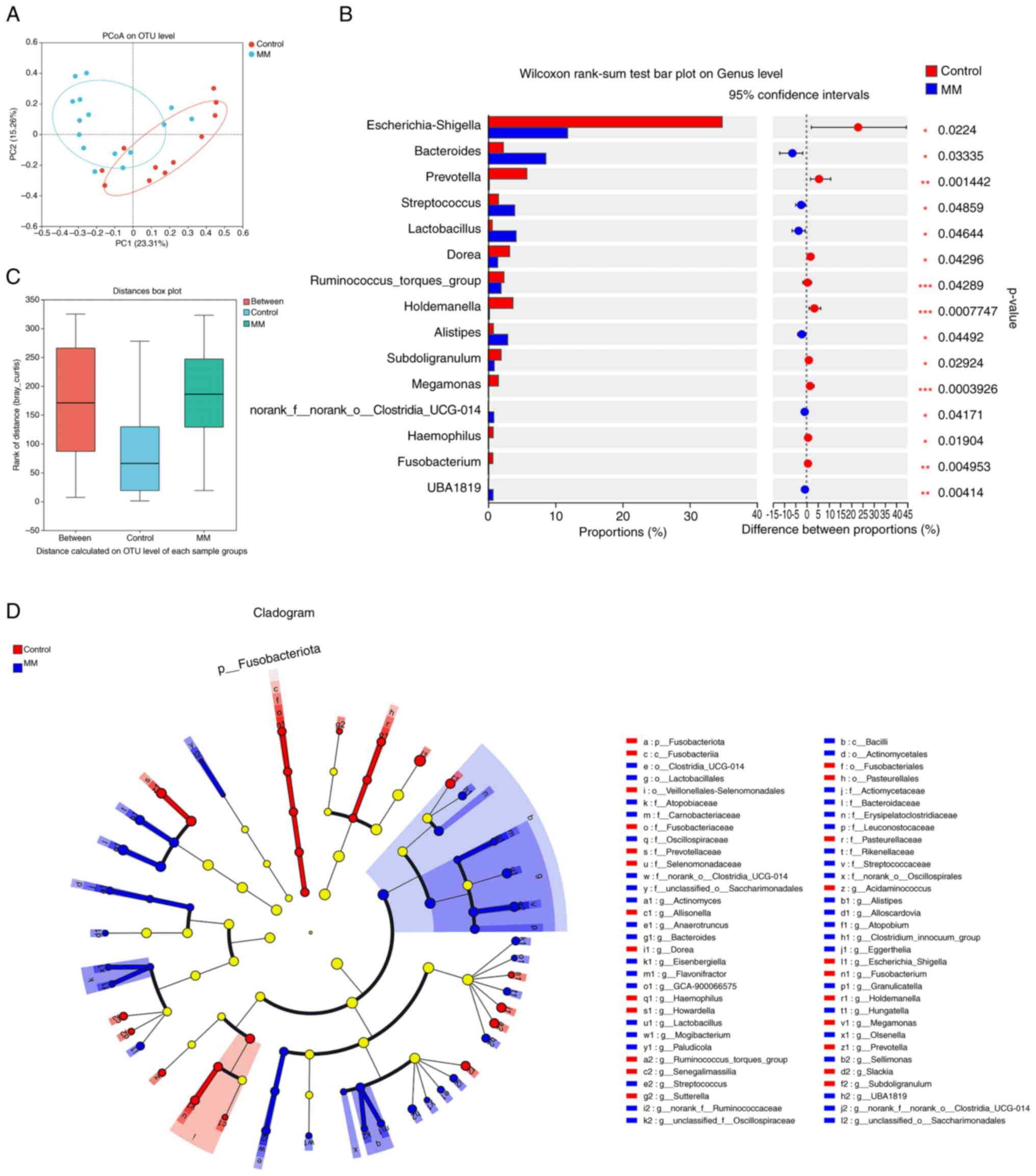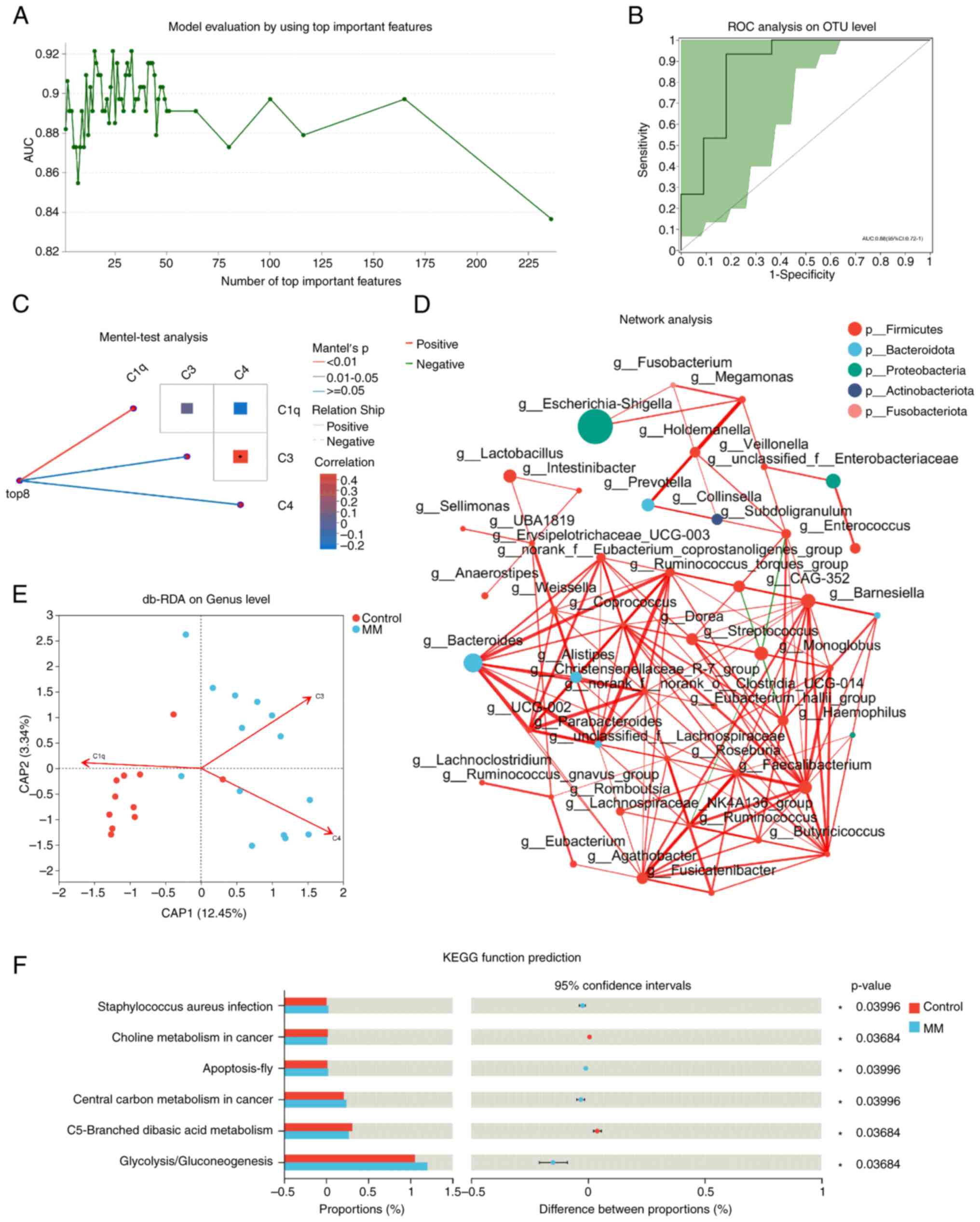|
1
|
van de Donk NWCJ, Pawlyn C and Yong KL:
Multiple myeloma. Lancet. 397:410–427. 2021.PubMed/NCBI View Article : Google Scholar
|
|
2
|
Pawlyn C and Morgan GJ: Evolutionary
biology of high-risk multiple myeloma. Nat Rev Cancer. 17:543–556.
2017.PubMed/NCBI View Article : Google Scholar
|
|
3
|
Cowan AJ, Allen C, Barac A, Basaleem H,
Bensenor I, Curado MP, Foreman K, Gupta R, Harvey J, Hosgood HD, et
al: Global Burden of multiple myeloma. JAMA Oncol. 4:1221–1227.
2018.PubMed/NCBI View Article : Google Scholar
|
|
4
|
Zhou L, Yu Q, Wei G, Wang L, Huang Y, Hu
K, Hu Y and Huang H: Measuring the global, regional, and national
burden of multiple myeloma from 1990 to 2019. BMC Cancer.
21(606)2021.PubMed/NCBI View Article : Google Scholar
|
|
5
|
Moreau P, Kumar SK, San Miguel J, Davies
F, Zamagni E, Bahlis N, Ludwig H, Mikhael J, Terpos E, Schjesvold
F, et al: Treatment of relapsed and refractory multiple myeloma:
Recommendations from the international myeloma working group.
Lancet Oncol. 22:e105–e118. 2021.PubMed/NCBI View Article : Google Scholar
|
|
6
|
Laubach J, Garderet L, Mahindra A, Gahrton
G, Caers J, Sezer O, Voorhees P, Leleu X, Johnsen HE, Streetly M,
et al: Management of relapsed multiple myeloma: Recommendations of
the international myeloma working group. Leukemia. 30:1005–1017.
2016.PubMed/NCBI View Article : Google Scholar
|
|
7
|
Rooks MG and Garrett WS: Gut microbiota,
metabolites and host immunity. Nat Rev Immunol. 16:341–352.
2016.PubMed/NCBI View Article : Google Scholar
|
|
8
|
Adak A and Khan MR: An insight into gut
microbiota and its functionalities. Cell Mol Life Sci. 76:473–493.
2019.PubMed/NCBI View Article : Google Scholar
|
|
9
|
Jasiński M, Biliński J and Basak GW: The
role of the gut microbiome in pathogenesis, biology, and treatment
of plasma cell dyscrasias. Front Oncol. 11(741376)2021.PubMed/NCBI View Article : Google Scholar
|
|
10
|
Cani PD: Human gut microbiome: Hopes,
threats and promises. Gut. 67:1716–1725. 2018.PubMed/NCBI View Article : Google Scholar
|
|
11
|
D'Angelo CR, Sudakaran S and Callander NS:
Clinical effects and applications of the gut microbiome in
hematologic malignancies. Cancer. 127:679–687. 2021.PubMed/NCBI View Article : Google Scholar
|
|
12
|
Landsverk OJ, Snir O, Casado RB, Richter
L, Mold JE, Réu P, Horneland R, Paulsen V, Yaqub S, Aandahl EM, et
al: Antibody-secreting plasma cells persist for decades in human
intestine. J Exp Med. 214:309–317. 2017.PubMed/NCBI View Article : Google Scholar
|
|
13
|
Stansborough RL and Gibson RJ: Proteasome
inhibitor-induced gastrointestinal toxicity. Curr Opin Support
Palliat Care. 11:133–137. 2017.PubMed/NCBI View Article : Google Scholar
|
|
14
|
Peled JU, Devlin SM, Staffas A, Lumish M,
Khanin R, Littmann ER, Ling L, Kosuri S, Maloy M, Slingerland JB,
et al: Intestinal microbiota and relapse after hematopoietic-cell
transplantation. J Clin Oncol. 35:1650–1659. 2017.PubMed/NCBI View Article : Google Scholar
|
|
15
|
Kusakabe S, Fukushima K, Maeda T, Motooka
D, Nakamura S, Fujita J, Yokota T, Shibayama H, Oritani K and
Kanakura Y: Pre- and post-serial metagenomic analysis of gut
microbiota as a prognostic factor in patients undergoing
haematopoietic stem cell transplantation. Br J Haematol.
188:438–449. 2020.PubMed/NCBI View Article : Google Scholar
|
|
16
|
D'Angelo C, Sudakaran S, Asimakopoulos F,
Hematti P, El-Gamal D, Safdar N and Callander N: Perturbation of
the gut microbiome and association with outcomes following
autologous stem cell transplantation in patients with multiple
myeloma. Leuk Lymphoma. 64:87–97. 2023.PubMed/NCBI View Article : Google Scholar
|
|
17
|
Rajkumar SV, Dimopoulos MA, Palumbo A,
Blade J, Merlini G, Mateos MV, Kumar S, Hillengass J, Kastritis E,
Richardson P, et al: International myeloma working group updated
criteria for the diagnosis of multiple myeloma. Lancet Oncol.
15:e538–e548. 2014.PubMed/NCBI View Article : Google Scholar
|
|
18
|
Cancro MP and Tomayko MM: Memory B cells
and plasma cells: The differentiative continuum of humoral
immunity. Immunol Rev. 303:72–82. 2021.PubMed/NCBI View Article : Google Scholar
|
|
19
|
Perini T, Materozzi M and Milan E: The
immunity-malignancy equilibrium in multiple myeloma: Lessons from
oncogenic events in plasma cells. FEBS J. 289:4383–4397.
2022.PubMed/NCBI View Article : Google Scholar
|
|
20
|
Alkharabsheh O, Sidiqi MH, Aljama MA,
Gertz MA and Frankel AE: The human microbiota in multiple myeloma
and proteasome inhibitors. Acta Haematol. 143:118–123.
2020.PubMed/NCBI View Article : Google Scholar
|
|
21
|
Ghobrial IM, Detappe A, Anderson KC and
Steensma DP: The bone-marrow niche in MDS and MGUS: Implications
for AML and MM. Nat Rev Clin Oncol. 15:219–233. 2018.PubMed/NCBI View Article : Google Scholar
|
|
22
|
Pepeljugoski AC, Morgan G and Braunstein
M: Analysis of intestinal microbiome in multiple myeloma reveals
progressive dysbiosis compared to MGUS and healthy individuals.
Blood. 134:3076. 2019.
|
|
23
|
Zhang B, Gu J, Liu J, Huang B and Li J:
Fecal microbiota taxonomic shifts in chinese multiple myeloma
patients analyzed by quantitative polimerase chain reaction (QPCR)
and 16S rRNA high-throughput sequencing. Med Sci Monit.
25:8269–8280. 2019.PubMed/NCBI View Article : Google Scholar
|
|
24
|
Calcinotto A, Brevi A, Chesi M, Ferrarese
R, Garcia Perez L, Grioni M, Kumar S, Garbitt VM, Sharik ME,
Henderson KJ, et al: Microbiota-driven interleukin-17-producing
cells and eosinophils synergize to accelerate multiple myeloma
progression. Nat Commun. 9(4832)2018.PubMed/NCBI View Article : Google Scholar
|
|
25
|
Yang R, Huang J, Ma H, Li S, Gao X, Liu Y,
Shen J and Liao A: Is complement C1q a potential marker for tumor
burden and immunodeficiency in multiple myeloma? Leukemia Lymphoma.
60:1812–1818. 2019.PubMed/NCBI View Article : Google Scholar
|
|
26
|
Zhang L, Ling X, Li F, Yang T, Shi K, Zhao
S, Yu L, Li Z and He H: Complement 4 aids in the prediction of
newly diagnosed multiple myeloma outcome in patients. Clin Med
Insights Oncol. 16(11795549221079171)2022.PubMed/NCBI View Article : Google Scholar
|
|
27
|
Liu X, Zhou Z and Sun D: Values of
immunoglobulin and complements for evaluating treatment outcomes of
patients with multiple myeloma. Clin Lab Nov. 1(69)2023.PubMed/NCBI View Article : Google Scholar
|
|
28
|
Jian X, Zhu Y, Ouyang J, Wang Y, Lei Q,
Xia J, Guan Y, Zhang J, Guo J, He Y, et al: Alterations of gut
microbiome accelerate multiple myeloma progression by increasing
the relative abundances of nitrogen-recycling bacteria. Microbiome.
8(74)2020.PubMed/NCBI View Article : Google Scholar
|
|
29
|
Pianko MJ, Devlin SM, Littmann ER,
Chansakul A, Mastey D, Salcedo M, Fontana E, Ling L, Tavitian E,
Slingerland JB, et al: Minimal residual disease negativity in
multiple myeloma is associated with intestinal microbiota
composition. Blood Adv. 3:2040–2044. 2019.PubMed/NCBI View Article : Google Scholar
|
|
30
|
El Jurdi N, Filali-Mouhim A, Salem I,
Retuerto M, Dambrosio NM, Baer L, Lazarus HM, Caimi P, Cooper B,
Tomlinson B, et al: Gastrointestinal microbiome and mycobiome
changes during autologous transplantation for multiple myeloma:
Results of a prospective pilot study. Biol Blood Marrow Transplant.
25:1511–1519. 2019.PubMed/NCBI View Article : Google Scholar
|
|
31
|
Hu Y, Li J, Ni F, Yang Z, Gui X, Bao Z,
Zhao H, Wei G, Wang Y, Zhang M, et al: CAR-T cell therapy-related
cytokine release syndrome and therapeutic response is modulated by
the gut microbiome in hematologic malignancies. Nat Commun.
13(5313)2022.PubMed/NCBI View Article : Google Scholar
|














